Stir frying is a quick and healthy cooking technique that originated in Chinese cuisine. It involves cooking small uniform pieces of meat and vegetables in a wok or skillet over very high heat while tossing and stirring them constantly.
The intense heat and constant movement cooks the food fast, sealing in moisture and flavor. Stir fries are meant to be cooked fast and eaten immediately. Their simplicity makes them an easy weeknight meal, but choosing the right cut of beef is key to getting optimal results.
When selecting beef for stir fry, you want a cut that is flavorful, tender, and slices thinly against the grain Thin slices are important, as they allow the beef to cook quickly without becoming tough or chewy Here is an overview of some of the best cuts of beef for stir fry, as well as tips on how to choose and prepare them.
Top Sirloin
Top sirloin is one of the most popular cuts for beef stir fry. It comes from the hip/rump region and ranks high in both tenderness and flavor. Top sirloin has a good amount of marbling, which keeps it moist and tender during the fast cooking process.
When shopping for top sirloin, look for steaks that are 3/4 to 1 inch thick, uniform in shape, and have some visible marbling. Avoid steaks with large chunks of fat, which won’t render down well in a stir fry.
To prepare top sirloin, first trim off any excess fat or silver skin. Then slice the meat very thinly against the grain into 2-3 inch long strips. Cutting against the grain shortens the muscle fibers, making the beef more tender. Marinating the strips for 30 minutes adds extra flavor.
Flank Steak
Flank steak comes from the belly region of the cow. It has excellent beefy flavor and relatively tender texture. Flank steak has visible longitudinal grain, so proper slicing is important for tenderness.
When shopping, choose flank steaks that are evenly thick, around 1-1.5 lbs, and bright red in color. Avoid those with thick cartilage running through them.
To prepare, first cut the flank steak into sections across the grain. Then slice each section thinly against the main grain. Marinate the meat for at least 30 minutes before stir frying to maximize tenderness. Flank steak doesn’t need a lot of time over high heat.
Skirt Steak
Skirt steak is a long, thin cut from the plate region near the belly. It has robust beefy flavor similar to flank steak. The grain runs along the length of the steak instead of across it.
When purchasing skirt steak, look for steaks around 3/4 inch thick with visibly coarse grain. Skirt steak is often sold folded in half; open it to inspect the grain before buying.
Slice skirt steak across the grain into thin 2-3 inch strips. Marinate for at least an hour, as it can be slightly tougher than flank or sirloin. Skirt steak can go from tender to chewy quickly, so don’t overcook.
Flat Iron Steak
Flat iron steak is cut from the chuck primal near the shoulder. It has excellent flavor and tenderness due to generous marbling. The connective tissue that runs through it must be removed to make it tender.
When selecting flat iron steaks, choose those that are at least 3/4 inch thick with nice marbling. Avoid pieces with thick connective tissue that hasn’t been removed.
Slice flat iron steaks thin across the prominent grain pattern. Marinate for 30-60 minutes to maximize tenderness before stir frying over high heat briefly.
Top Blade Steak
Top blade steak, also called chicken steak, comes from the chuck shoulder region. It has great beefy flavor and decent tenderness when sliced properly.
Look for top blade steaks that are 3/4 to 1 inch thick with some marbling. Pass on steaks with large pieces of connective tissue that can’t be removed.
Slice top blade steak paper thin across the grain before marinating. Cutting against the prominent grain is key to keeping it tender during cooking.
Tri-Tip Roast
Tri-tip is a small triangular roast cut from the bottom sirloin. It has excellent flavor and tenderness due to its fine grain and moderate marbling.
When shopping, look for whole tri-tip roasts that are 1.5-2.5 lbs, firm, and evenly marbled. Pre-cut steaks work too, but may have more connective tissue.
Slice the roast or steaks across the grain into thin strips. Marinate for 1 hour before stir frying briefly over high heat to medium rare doneness.
Chuck Eye Steak
The chuck eye steak comes from the center of the chuck primal. It’s known for its beefy flavor and decent tenderness similar to ribeye.
Look for chuck eye steaks that are 1-1.5 inches thick with nice marbling. Pass on steaks with large sections of connective tissue.
Trim excess fat and slice the steak paper thin against the grain. Marinate the slices for at least an hour before stir frying over high heat just until cooked through.
Bavette Steak
Bavette steak, also called flap steak, comes from the bottom sirloin primal. It has loose grain and good flavor that compares to flank and skirt steak.
When shopping, look for bavette steaks that are around 1 inch thick with visible grain. Avoid extremely thin or unevenly cut steaks.
Cut bavette steak against the prominent grain into very thin slices. Marinate for 1-2 hours as it can be slightly tough if not prepared properly.
Tips for Preparing Beef for Stir Fry
-
Always slice beef against the grain into thin, uniform strips or slices. This makes the meat shorter and more tender.
-
Partially freeze beef for 30-60 minutes before slicing to make cutting thinner pieces easier.
-
Trim off any silver skin or excessive fat before slicing to prevent chewing on gristle.
-
Marinate beef in an acidic ingredient like wine, vinegar, citrus, or yogurt for at least 30 minutes up to overnight.
-
Velveting beef in a cornstarch slurry before cooking also helps tenderize it.
-
Don’t overcook beef in the stir fry. Cook over high heat just until no longer pink inside.
-
Let meat come to room temperature before cooking so it sears versus steams.
-
Pat meat very dry before stir frying to help achieve nice browning.
With the right cut of beef and proper preparation methods, you can enjoy restaurant-quality beef stir fry at home any night of the week. Experiment with different cuts to find your favorites. Just remember to slice against the grain, marinate, and use high heat to sear and seal in all the flavorful juices.
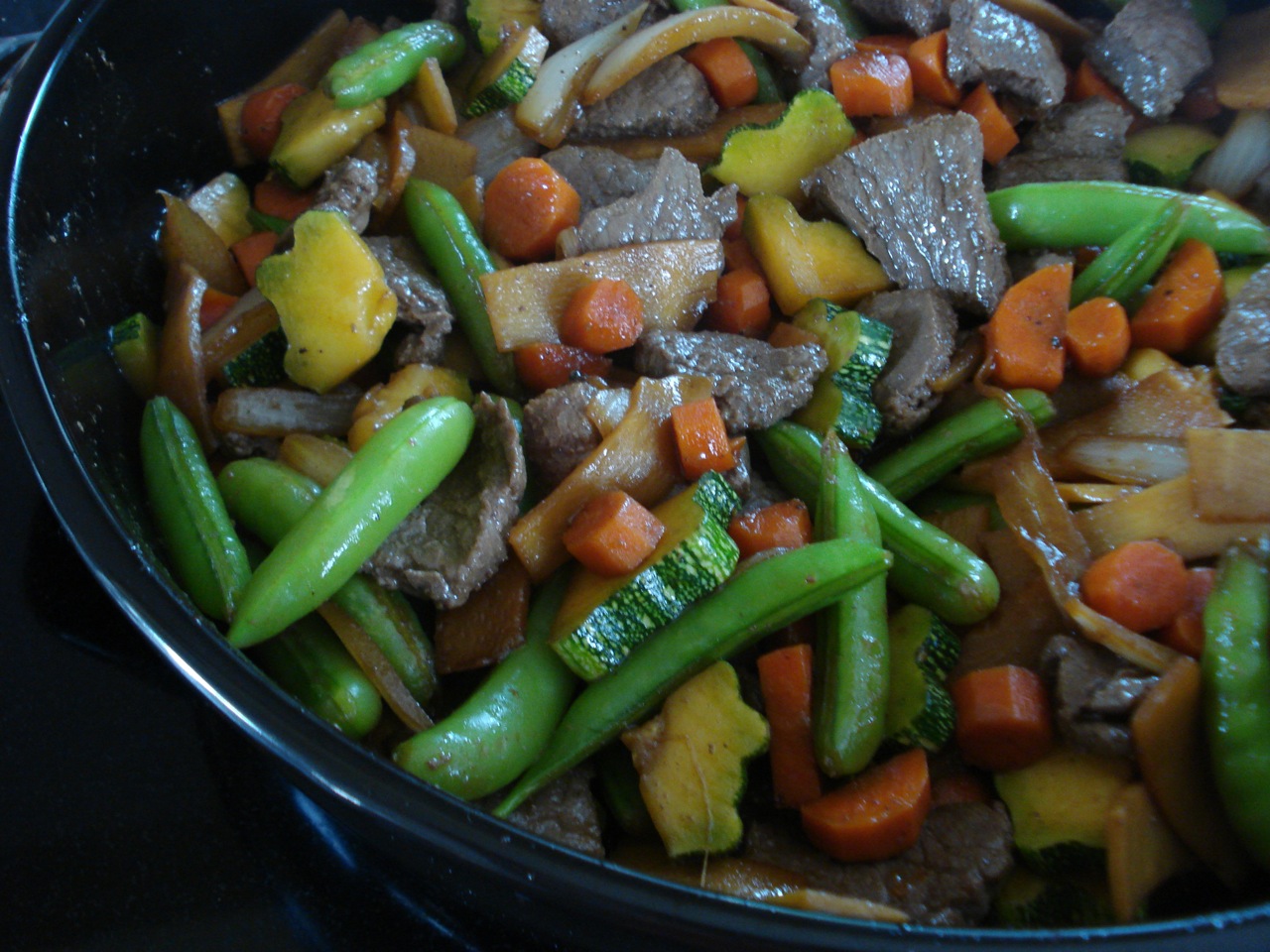
Shortcut to Tenderizing Beef at Home
If the process used by Chinese restaurants to tenderize beef described above sounds a bit like a hassle, you can still tenderize beef using a shortcut.
Baking soda is a powerful tenderizer, but if you add too much, it can add an off-taste to the beef. This is why you need to rinse it off.
The solution is to add a smaller amount of baking soda without rinsing it off. Adding 1/8 teaspoon to 1/4 teaspoon (depending on how tough the cut is) of baking soda and 2 to 3 tablespoons of water per pound of beef.
You can add it along with the rest of your marinade ingredients. Increase the marinating time for your beef by about 15 minutes (or let it sit overnight).
This method is simpler and yields a slightly less tender beef that will retain more of its flavor.
I will also say that adding water to the beef is a personal choice. I feel there are merits to having both moist hydrated beef or a drier beef for some stir-fry dishes.
The marinade isn’t about soaking the beef in liquid or adding a bunch of aromatics and spices like you may be used to. It’s about giving the beef an extra juicy texture.
After the beef has been tenderized:
- Add oyster sauce and/or soy sauce to give your beef an extra flavor boost. Add about 2 teaspoons of each per pound of beef.
- Add cornstarch and oil to give the meat a velvety texture. Add about 2 teaspoons of each per pound of beef.
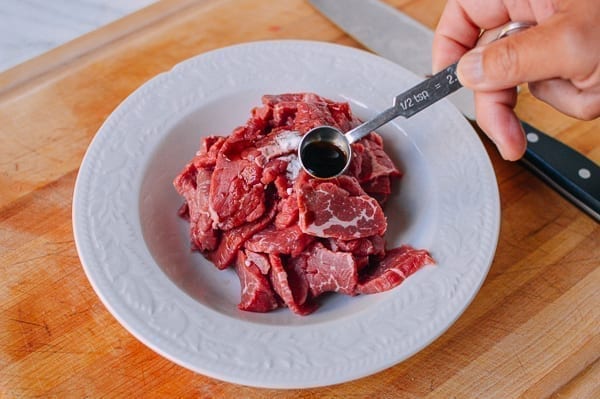
The cornstarch and oil gives the beef its velvety smooth texture, protecting the meat during cooking.
Adding Shaoxing wine (2 teaspoons per pound) also adds flavor. This is totally optional for those of you who would rather not consume alcohol.
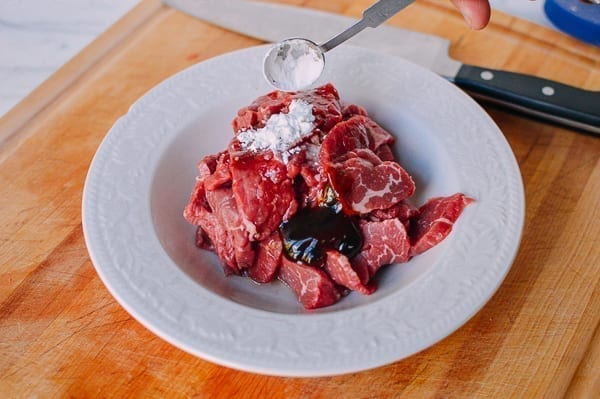
3. Mix everything together and set it aside to marinate for 15-30 minutes while you’re preparing your other ingredients.
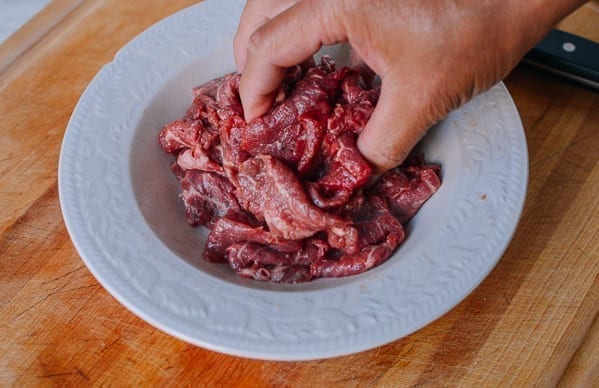
How Chinese Restaurants Tenderize Beef
It’s time to share some Chinese restaurant secrets on how to tenderize beef. Depending on the cut of beef, you may want to tenderize it as a first step before completing the marinating and velveting process.
The first step is to add a good amount of baking soda to the beef––about 1 teaspoon per pound (450g).
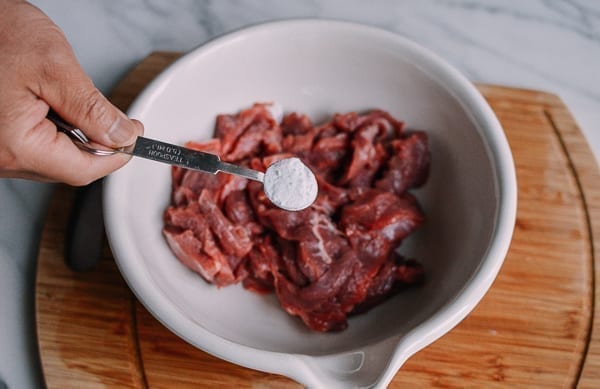
Next, add 1/4 cup (60 ml) water (per pound of beef), and massage the beef so the baking soda and water is uniformly distributed. Set aside for 1-2 hours. This step tenderizes (baking soda) and hydrates (water) the beef.
Next, the beef must be rinsed thoroughly under running water to rid it of any excess baking soda, or you will taste it in the dish.
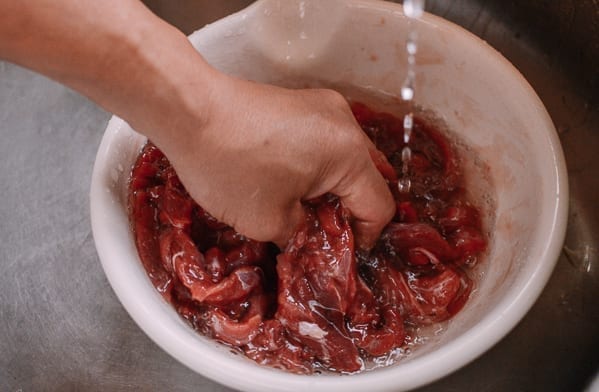
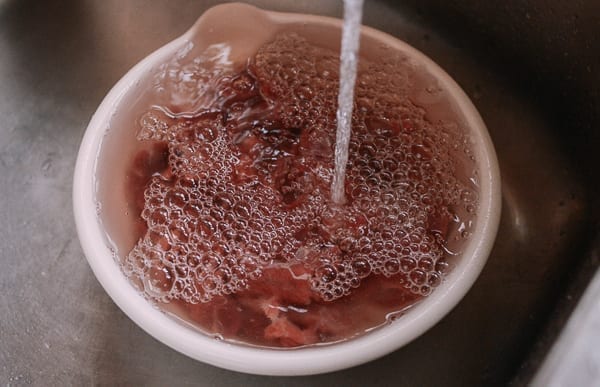
Use your hands to stir up the beef during the rinsing process.
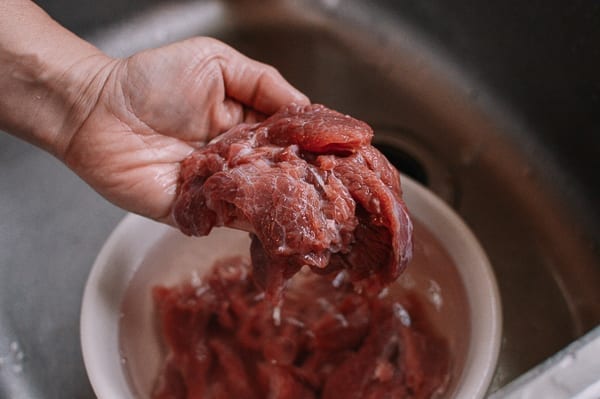
Once the water runs clear, drain the beef thoroughly in a colander and transfer it to a bowl for the marinating process (details in next section).
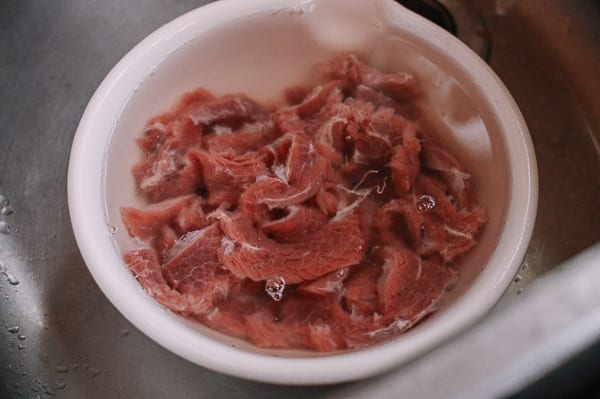
DON’T put baking soda in beef marinade – The RIGHT way to tenderize beef for stir fries
FAQ
What is the best cut of beef for stir-fry?
-
The Woks of Lifehttps://thewoksoflife.comHow to Velvet Beef for Stir-fry – The Woks of LifeJul 7, 2019 — What Cut of Beef is Best for Stir-fry? Flank steak is by far the most popular cut of meat for stir-fry dishes. It also happens to be the cut we most …
What cut of beef do Chinese restaurants use?
-
Flank Steak:A lean, flavorful cut that’s versatile and often used in stir-fries due to its ability to be sliced thinly against the grain for tenderness.
-
Sirloin:A good, flavorful cut that can be used in stir-fries and other dishes.
-
Chuck Steak:A more economical option that can be used for stir-fries if sliced and tenderized properly.
-
Ribeye:A juicy, marbled cut of beef that can be used in stir-fries and other dishes.
-
Beef Tenderloin:A very tender and flavorful cut, often used in more upscale dishes.
What part of beef is best for beef fry?
- Rump steak.
- Sirloin or Porterhouse.
- Fillet or Tenderloin.
- Blade or Topside work ok, but can get a bit tough.
Which meat is best for stir fry?
Also known as Culotte, the Picanha is another contender for go-to meat for stir-fry. It is lean and tasty and when cut properly after maturing stands up with the best cuts. This cut is also excellent but heading back up the price ladder. Good flavor, higher cost and works well in many dishes.
Is beef good for stir-fry?
Good for grilling or broiling. The secret to a great stir-fry is selecting the right protein – and these beef cuts are all proven winners. Assemble your favorite veggies, sauce and one of these stir-fry-friendly beef cuts to deliver a delicious one-skillet meal that’s sure to impress.
Which steak is best for stir-fry?
Flank steak is by far the most popular cut of meat for stir-fry dishes. It also happens to be the cut we most often recommend in our stir-fry recipes. Flank steak is flavorful, relatively reasonably priced (though it is becoming more expensive), and readily available.
Is Beef clod good for stir fry?
The centre muscle in the Beef Clod (we call it Top Rib, Housekeeper’s Cut, Cross Rib or LMC. In the USA it can be called Ranch Steak) is a little used cut that is very good for stir-fry. When matured for at least 14 days, this cut is tender and has a great beef flavor. Very affordable.
What is a good cut of steak for a stir fry?
Cut from the center of the Under Blade, these steaks are extremely tender with a good amount of marbling and beef flavor. Best when cooked over high heat on the grill. Affordable, lean and versatile. Good for grilling or broiling. The secret to a great stir-fry is selecting the right protein – and these beef cuts are all proven winners.
What makes a good stir frying beef?
Absolutely everything has to meld together with the perfect bite of juicy meat front and center. Since stir frying is a high-heat, quick-cooking method, the beef needs to be lean but not dry, tender but not mushy, and able to hold up to a solid marinating technique to get that ultimate level of tenderness without falling apart.
